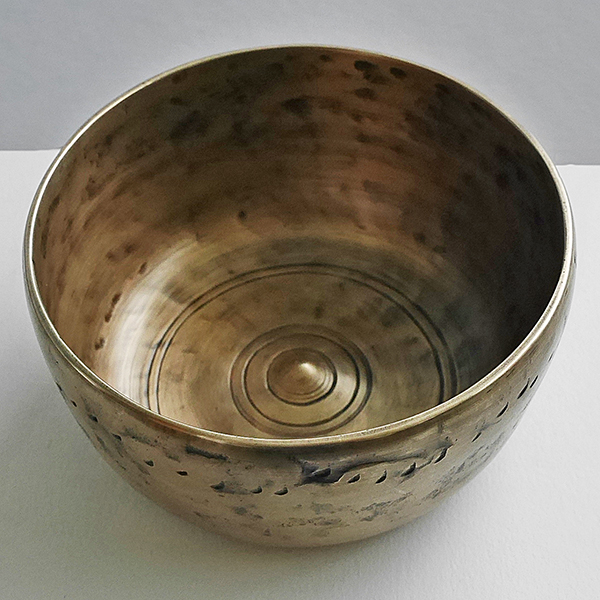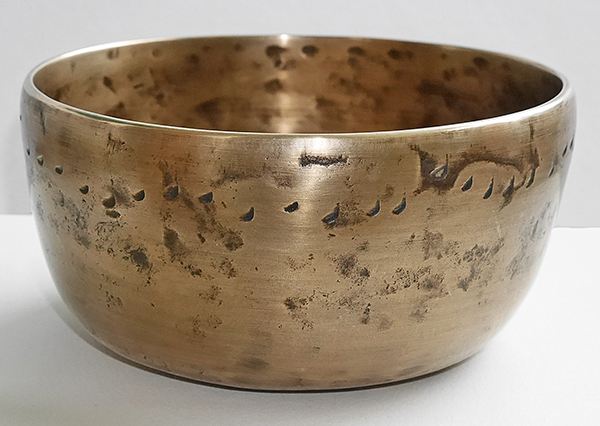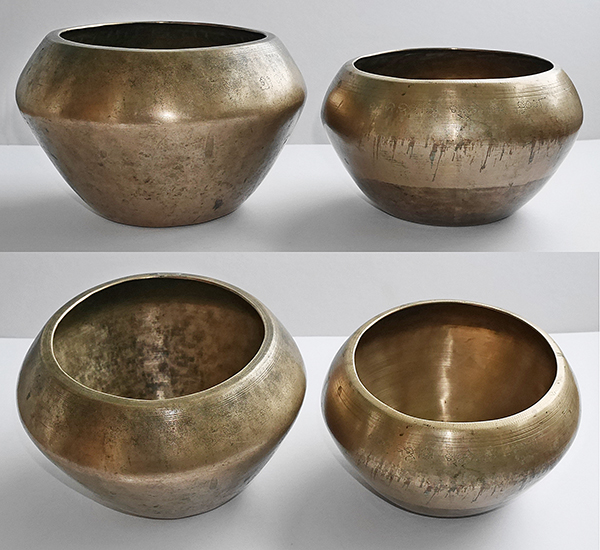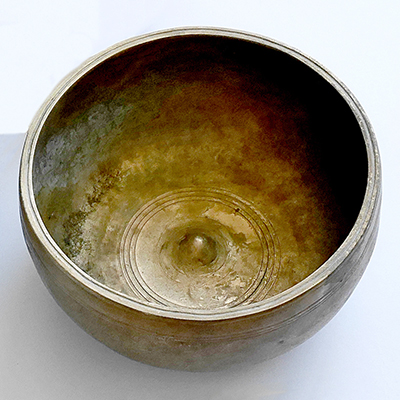How to Spot a Fake or Repro Bowl
 FAKE ANTIQUE LINGAM BOWL: We came across several fake or reproduction singing bowls masquerading as authentic antiques on our recent trip to Nepal. This one caught my eye because it purports to be a rare and valuable antique Lingam bowl, and could so easily have fooled an unsuspecting customer into parting with some serious money. Here’s what I found:
FAKE ANTIQUE LINGAM BOWL: We came across several fake or reproduction singing bowls masquerading as authentic antiques on our recent trip to Nepal. This one caught my eye because it purports to be a rare and valuable antique Lingam bowl, and could so easily have fooled an unsuspecting customer into parting with some serious money. Here’s what I found:
1). The shape is good, and based on the high-wall Thadobati type of Lingam, but it has been cast, not forged by hand. The walls are perfectly regular, with no sign of hammer marks, but it has been ‘finished’ by hand.
2). Although it appears a bit beaten up, with scars and digs, there’s no sign of actual wear and tear, or stains, as one might expect in an old bowl. The rim is regular and unworn.
3). The deep scars and the band of ritual gashes that encircle the bowl below the rim have been deliberately applied to mislead. And for good measure they’ve added a few inside too. Ritual gashes are sometimes found on 18th and 19th century Thadobati and Manipuri bowls…but very rarely on a lingam, and never inside. If genuine they would appear in seemingly random groups of 3 to 8 cuts separated by gaps, not in a continuous unbroken chain around the bowl as in this example.
 4). The lingam at its centre, and the concentric circles surrounding it, are suspiciously sharp and well defined, with absolutely no evidence of the wear that one might expect from years of use and cleaning. The navel underneath is small and shallow.
4). The lingam at its centre, and the concentric circles surrounding it, are suspiciously sharp and well defined, with absolutely no evidence of the wear that one might expect from years of use and cleaning. The navel underneath is small and shallow.
5). The whole bowl has been ‘antiqued’ with a coat of coloured lacquer to make it look old. The bowl has no natural surface patina (grime) and just doesn’t look or feel right. This rare ‘antique’ bowl was also available in several sizes!
6). It sings and plays quite readily…but has nothing like the quality of sound produced by a genuine hand-forged multi-harmonic antique singing bowl. This bowl is brand new!
FAKE RARE SINGING BOWL: These two unusual singing bowls came from the same Nepalese source. Although they appear virtually identical in all but size, the one on the left is a genuine and valuable antique, while the other is a fairly worthless modern reproduction. The dealer made no distinction between the two, and it would have been easy for an unsuspecting customer to buy the reproduction bowl mistaking it for the antique. Here’s what I found:

1). The shape is good. It is very like the genuine item, although it’s a little small for this rare bowl form and the walls are thinner than normal.
2). Although the outer wall is scratched, tarnished and lightly stained as one might expect of an old bowl, the inside tells a different story. It is bright, spotless, pristine, and there is clear evidence of recent machining. The lower part of this bowl has been crudely ‘antiqued’ with a coat of coloured lacquer to make it appear more interesting. The genuine antique bowl on the left also has numerous small stains and a variety of surface blemishes...variety being the keynote! The outside has a mature and uniform tarnish, while the inside looks used and grubby.
3). The flat surface of the lip displays recent signs of mechanical buffing, while the playing edge remains completely unworn. It’s doubtful if the bowl on the right has ever been played around the rim. The antique bowl has a grooved lip, now faint from wear, and its playing edge is smooth. Two decorative bands of sun motifs (a dot surrounded by a circle) encircle the bowl below the rim, the lower of the two with drops.
4). Old bowls sometimes carry inscriptions, and they always add interest and value. The fake bowl has a nice big one below the rim, but the give-away is its surface texture. Old inscriptions wear down with handling and cleaning; they feel smooth, while recent ones feel raw and prickly to the touch. Guess what this one feels like? Of course, it’s always possible that a new owner of an antique bowl might have decided to have it inscribed…but then it probably wouldn’t have been so quickly in the hands of a bowl dealer. This bowl is brand new! The antique bowl on the left carries a large and beautiful dot-punched inscription set between a pair of peacocks. It is smooth to the touch and overlaid with stains in places.
5). Singing bowls with this unusual form are extremely uncommon, and yet the one on the right was one of 14 similar bowls on offer…just two of which were authentic antiques, including the excellent specimen on the left. Unfortunately it proved to be damaged. It has a 2cm split in the lower wall. The struck note is still good. The rim note is not. Please use the contact form if you are interested in it.
 VALUABLE LINGAM OR ‘UPGRADED’ THADOBATI BOWL? This interesting antique singing bowl looks like a typical Thadobati style Lingam. It has a 6¾" diameter, weighs 1.12 kilos and has nice features…extra thick walls, boldly grooved lip, a decorative band below the rim and circles around a prominent lingam. Lingam bowls are rare and expensive, and as such its Western market value would be around £725 (about $1,125).
VALUABLE LINGAM OR ‘UPGRADED’ THADOBATI BOWL? This interesting antique singing bowl looks like a typical Thadobati style Lingam. It has a 6¾" diameter, weighs 1.12 kilos and has nice features…extra thick walls, boldly grooved lip, a decorative band below the rim and circles around a prominent lingam. Lingam bowls are rare and expensive, and as such its Western market value would be around £725 (about $1,125).
However, on close inspection the entire lingam at its centre appears to have been replaced or rebuilt, and this begs the question of whether this is an authentic Lingam bowl that has been repaired or restored...or if it actually started life as a nice but less rare and much cheaper Thadobati with a Western market value of around £250 (about $385).
At today's inflated Lingam prices it's quite possible that this is an ‘upgraded’ Thadobati with a completely new insert or an old lingam cut from a damaged bowl. In this instance it's difficult to say.
A sensitively restored antique Lingam bowl might have some value if the sound is good, especially if it's a particularly rare specimen, but a fake one is little more than a curiosity...so BUYER BEWARE! See this bowl here.

 Print this page
Print this page